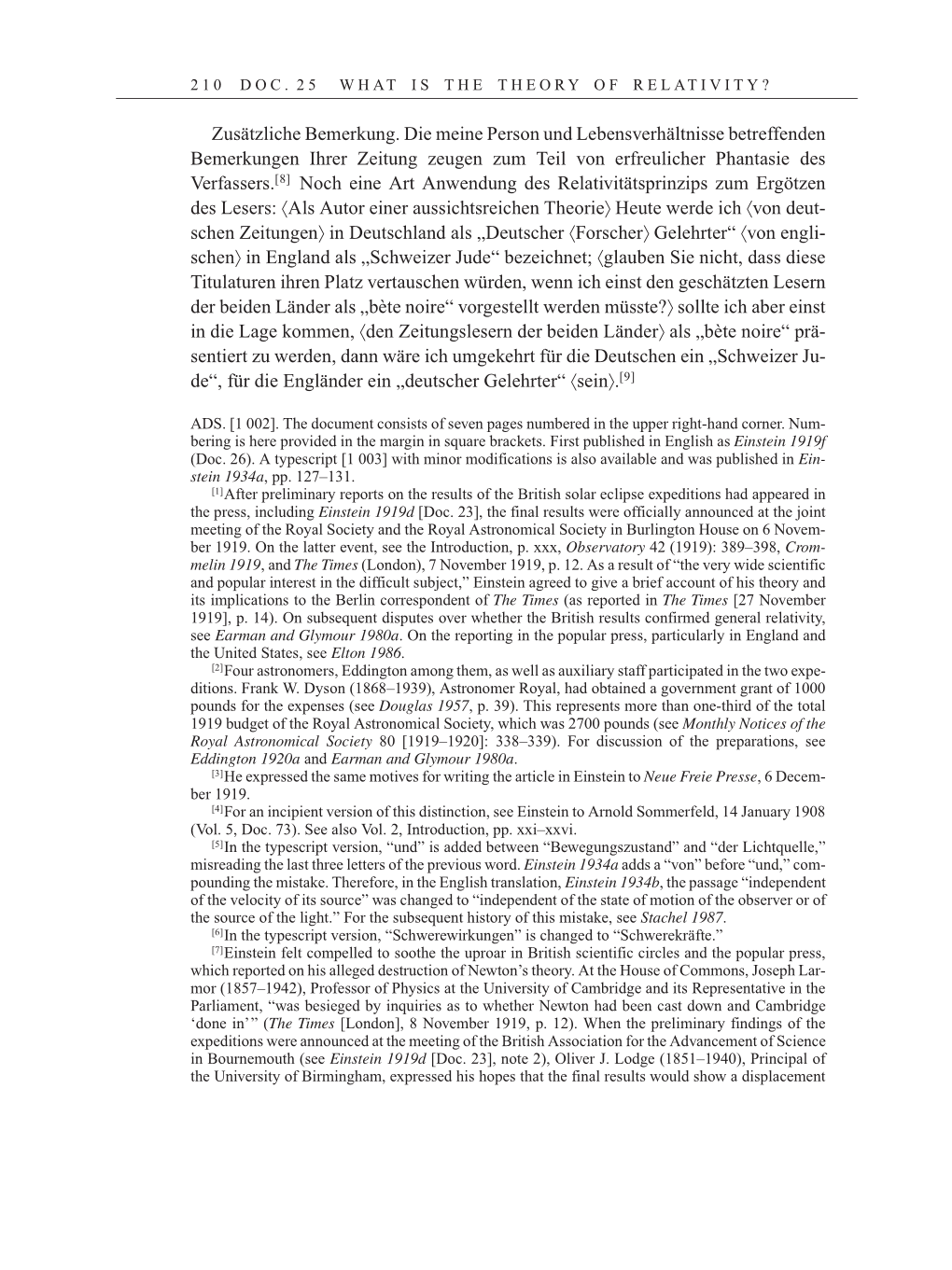2 1 0 D O C . 2 5 W H AT I S T H E T H E O R Y O F R E L AT I V I T Y ?
Zusätzliche Bemerkung. Die meine Person und Lebensverhältnisse betreffenden
Bemerkungen Ihrer Zeitung zeugen zum Teil von erfreulicher Phantasie des
Verfassers.[8]
Noch eine Art Anwendung des Relativitätsprinzips zum Ergötzen
des Lesers: áAls Autor einer aussichtsreichen Theorieñ Heute werde ich ávon deut-
schen Zeitungenñ in Deutschland als „Deutscher áForscherñ Gelehrter“ ávon engli-
schenñ in England als „Schweizer Jude“ bezeichnet; áglauben Sie nicht, dass diese
Titulaturen ihren Platz vertauschen würden, wenn ich einst den geschätzten Lesern
der beiden Länder als „bète noire“ vorgestellt werden müsste?ñ sollte ich aber einst
in die Lage kommen, áden Zeitungslesern der beiden Länderñ als „bète noire“ prä-
sentiert zu werden, dann wäre ich umgekehrt für die Deutschen ein „Schweizer Ju-
de“, für die Engländer ein „deutscher Gelehrter“
áseinñ.[9]
ADS. [1 002]. The document consists of seven pages numbered in the upper right-hand corner. Num-
bering is here provided in the margin in square brackets. First published in English as Einstein 1919f
(Doc. 26). A typescript [1 003] with minor modifications is also available and was published in Ein-
stein 1934a, pp. 127–131.
[1]After preliminary reports on the results of the British solar eclipse expeditions had appeared in
the press, including Einstein 1919d [Doc. 23], the final results were officially announced at the joint
meeting of the Royal Society and the Royal Astronomical Society in Burlington House on 6 Novem-
ber 1919. On the latter event, see the Introduction, p. xxx, Observatory 42 (1919): 389–398, Crom-
melin 1919, and The Times (London), 7 November 1919, p. 12. As a result of “the very wide scientific
and popular interest in the difficult subject,” Einstein agreed to give a brief account of his theory and
its implications to the Berlin correspondent of The Times (as reported in The Times [27 November
1919], p. 14). On subsequent disputes over whether the British results confirmed general relativity,
see Earman and Glymour 1980a. On the reporting in the popular press, particularly in England and
the United States, see Elton 1986.
[2]Four astronomers, Eddington among them, as well as auxiliary staff participated in the two expe-
ditions. Frank W. Dyson (1868–1939), Astronomer Royal, had obtained a government grant of 1000
pounds for the expenses (see Douglas 1957, p. 39). This represents more than one-third of the total
1919 budget of the Royal Astronomical Society, which was 2700 pounds (see Monthly Notices of the
Royal Astronomical Society 80 [1919–1920]: 338–339). For discussion of the preparations, see
Eddington 1920a and Earman and Glymour 1980a.
[3]He expressed the same motives for writing the article in Einstein to Neue Freie Presse, 6 Decem-
ber 1919.
[4]For an incipient version of this distinction, see Einstein to Arnold Sommerfeld, 14 January 1908
(Vol. 5, Doc. 73). See also Vol. 2, Introduction, pp. xxi–xxvi.
[5]In the typescript version, “und” is added between “Bewegungszustand” and “der Lichtquelle,”
misreading the last three letters of the previous word. Einstein 1934a adds a “von” before “und,” com-
pounding the mistake. Therefore, in the English translation, Einstein 1934b, the passage “independent
of the velocity of its source” was changed to “independent of the state of motion of the observer or of
the source of the light.” For the subsequent history of this mistake, see Stachel 1987.
[6]In the typescript version, “Schwerewirkungen” is changed to “Schwerekräfte.”
[7]Einstein felt compelled to soothe the uproar in British scientific circles and the popular press,
which reported on his alleged destruction of Newton’s theory. At the House of Commons, Joseph Lar-
mor (1857–1942), Professor of Physics at the University of Cambridge and its Representative in the
Parliament, “was besieged by inquiries as to whether Newton had been cast down and Cambridge
‘done in’” (The Times [London], 8 November 1919, p. 12). When the preliminary findings of the
expeditions were announced at the meeting of the British Association for the Advancement of Science
in Bournemouth (see Einstein 1919d [Doc. 23], note 2), Oliver J. Lodge (1851–1940), Principal of
the University of Birmingham, expressed his hopes that the final results would show a displacement
